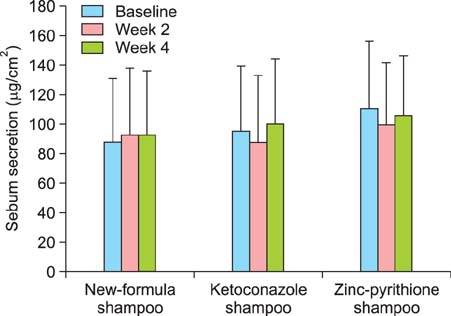Ann Dermatol.
2014 Dec;26(6):733-738. 10.5021/ad.2014.26.6.733.
Clinical Evaluation of a New-Formula Shampoo for Scalp Seborrheic Dermatitis Containing Extract of Rosa centifolia Petals and Epigallocatechin Gallate: A Randomized, Double-Blind, Controlled Study
- Affiliations
-
- 1Department of Dermatology, Konkuk University School of Medicine, Konkuk University, Seoul, Korea. 20050078@kuh.ac.kr
- 2Research Institute of Medical Science, Konkuk University, Seoul, Korea.
- 3AmorePacific R&D Center, Yongin, Korea.
- KMID: 2264869
- DOI: http://doi.org/10.5021/ad.2014.26.6.733
Abstract
- BACKGROUND
Scalp seborrheic dermatitis is a chronic type of inflammatory dermatosis that is associated with sebum secretion and proliferation of Malassezia species. Ketoconazole or zinc-pyrithione shampoos are common treatments for scalp seborrheic dermatitis. However, shampoos comprising different compounds are required to provide patients with a wider range of treatment options.
OBJECTIVE
This study was designed to evaluate a new-formula shampoo that contains natural ingredients-including extract of Rosa centifolia petals and epigallocatechin gallate (EGCG)-that exert antioxidative, anti-inflammatory, and sebum secretion inhibitory effects, and antifungal agents for the treatment of scalp seborrheic dermatitis.
METHODS
Seventy-five patients were randomized into three treatment groups; new-formula shampoo, 2% ketoconazole shampoo, and 1% zinc- pyrithione shampoo. The clinical severity scores and sebum levels were assessed by the same dermatologists at baseline (week 0), and at 2 and 4 weeks after using the shampoo. User satisfaction and irritation were also assessed with the aid of a questionnaire.
RESULTS
The efficacy of the new-formula shampoo was comparable to that of both the 1% zinc-pyrithione shampoo and the 2% ketoconazole shampoo. Furthermore, it was found to provide a more rapid response than the 1% zinc-pyrithione shampoo for mild erythema lesions and was associated with greater user satisfaction compared with the 2% ketoconazole shampoo. However, the new-formula shampoo did not exhibit the previously reported sebum inhibitory effect.
CONCLUSION
Extract of R. centifolia petals or EGCG could be useful ingredients in the treatment of scalp seborrheic dermatitis.
Keyword
MeSH Terms
Figure
Cited by 3 articles
-
Pharmacologic treatment of seborrheic dermatitis
Min Seok Hur, Yang Won Lee
J Korean Med Assoc. 2017;60(5):409-416. doi: 10.5124/jkma.2017.60.5.409.Progress in Malassezia Research in Korea
Soo Young Kim, Yang Won Lee, Yong Beom Choe, Kyu Joong Ahn
Ann Dermatol. 2015;27(6):647-657. doi: 10.5021/ad.2015.27.6.647.In Vitro Anti-Malassezia Activity of Castanea crenata Shell and Oil-Soluble Glycyrrhiza Extracts
Song Hee Han, Min Seok Hur, Min Jung Kim, Won Hee Jung, Minji Park, Jeong Hwan Kim, Hong Ju Shin, Yong Beom Choe, Kyu Joong Ahn, Yang Won Lee
Ann Dermatol. 2017;29(3):321-326. doi: 10.5021/ad.2017.29.3.321.
Reference
-
1. De Luca C, Valacchi G. Surface lipids as multifunctional mediators of skin responses to environmental stimuli. Mediators Inflamm. 2010; 2010:321494.
Article2. DeAngelis YM, Gemmer CM, Kaczvinsky JR, Kenneally DC, Schwartz JR, Dawson TL Jr. Three etiologic facets of dandruff and seborrheic dermatitis: Malassezia fungi, sebaceous lipids, and individual sensitivity. J Investig Dermatol Symp Proc. 2005; 10:295–297.
Article3. Passi S, Picardo M, Morrone A, De Luca C, Ippolito F. Skin surface lipids in HIV sero-positive and HIV sero-negative patients affected with seborrheic dermatitis. J Dermatol Sci. 1991; 2:84–91.
Article4. Baroni A, Orlando M, Donnarumma G, Farro P, Iovene MR, Tufano MA, et al. Toll-like receptor 2 (TLR2) mediates intracellular signalling in human keratinocytes in response to Malassezia furfur. Arch Dermatol Res. 2006; 297:280–288.
Article5. Faergemann J, Bergbrant IM, Dohsé M, Scott A, Westgate G. Seborrhoeic dermatitis and Pityrosporum (Malassezia) folliculitis: characterization of inflammatory cells and mediators in the skin by immunohistochemistry. Br J Dermatol. 2001; 144:549–556.
Article6. Park D, Jeon JH, Kwon SC, Shin S, Jang JY, Jeong HS, et al. Antioxidative activities of white rose flower extract and pharmaceutical advantages of its hexane fraction via free radical scavenging effects. Biochem Cell Biol. 2009; 87:943–952.
Article7. Jeon JH, Kwon SC, Park D, Shin S, Jeong JH, Park SY, et al. Anti-allergic effects of white rose petal extract and anti-atopic properties of its hexane fraction. Arch Pharm Res. 2009; 32:823–830.
Article8. Kondo H, Hashizume K, Shibuya Y, Hase T, Murase T. Identification of diacylglycerol acyltransferase inhibitors from Rosa centifolia petals. Lipids. 2011; 46:691–700.
Article9. Wakimoto K, Chiba H, Michibata H, Seishima M, Kawasaki S, Okubo K, et al. A novel diacylglycerol acyltransferase (DGAT2) is decreased in human psoriatic skin and increased in diabetic mice. Biochem Biophys Res Commun. 2003; 310:296–302.
Article10. Singh BN, Shankar S, Srivastava RK. Green tea catechin, epigallocatechin-3-gallate (EGCG): mechanisms, perspectives and clinical applications. Biochem Pharmacol. 2011; 82:1807–1821.
Article11. Yoon JY, Kwon HH, Min SU, Thiboutot DM, Suh DH. Epigallocatechin-3-gallate improves acne in humans by modulating intracellular molecular targets and inhibiting P. acnes. J Invest Dermatol. 2013; 133:429–440.
Article12. Kwon OS, Han JH, Yoo HG, Chung JH, Cho KH, Eun HC, et al. Human hair growth enhancement in vitro by green tea epigallocatechin-3-gallate (EGCG). Phytomedicine. 2007; 14:551–555.
Article13. Shin H, Kwon OS, Won CH, Kim BJ, Lee YW, Choe YB, et al. Clinical efficacies of topical agents for the treatment of seborrheic dermatitis of the scalp: a comparative study. J Dermatol. 2009; 36:131–137.
Article14. Como JA, Dismukes WE. Oral azole drugs as systemic antifungal therapy. N Engl J Med. 1994; 330:263–272.
Article15. Andersson DA, Gentry C, Moss S, Bevan S. Clioquinol and pyrithione activate TRPA1 by increasing intracellular Zn2+. Proc Natl Acad Sci U S A. 2009; 106:8374–8379.
Article16. Lademann J, Richter H, Teichmann A, Otberg N, Blume-Peytavi U, Luengo J, et al. Nanoparticles--an efficient carrier for drug delivery into the hair follicles. Eur J Pharm Biopharm. 2007; 66:159–164.
Article
- Full Text Links
- Actions
-
Cited
- CITED
-
- Close
- Share
- Similar articles
-
- Clinical and Biochemical Assessment of New-formula Shampoo for Scalp Seborrheic Dermatitis
- Pityrosporum(Malassezia) Related Diseases Especially Seborrheic Dermatitis
- Clinical effect of topical ketoconazole in seborrheic dermatitis of scalp
- Clinical Efficacy for 1% Zinc Pyrithione Shampoo for the Treatment of Dandruff
- In Vitro Anti-Malassezia Activity of Castanea crenata Shell and Oil-Soluble Glycyrrhiza Extracts



